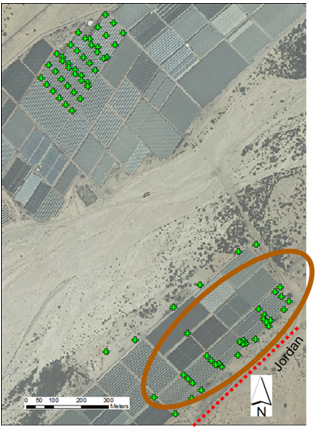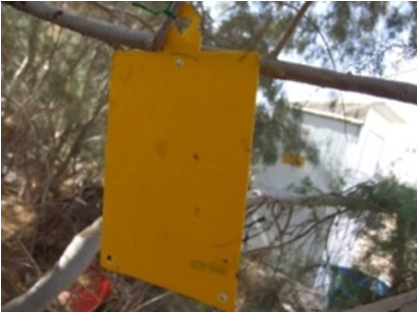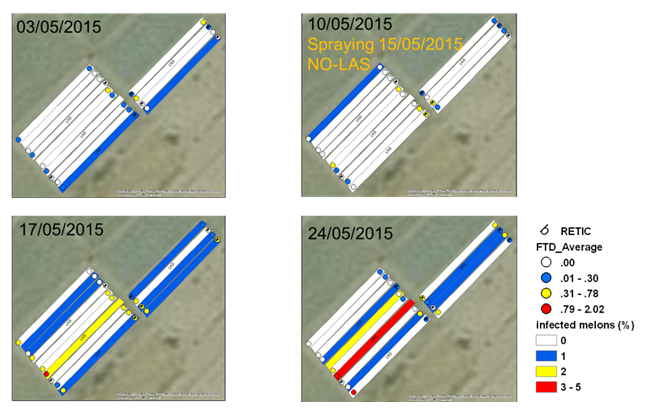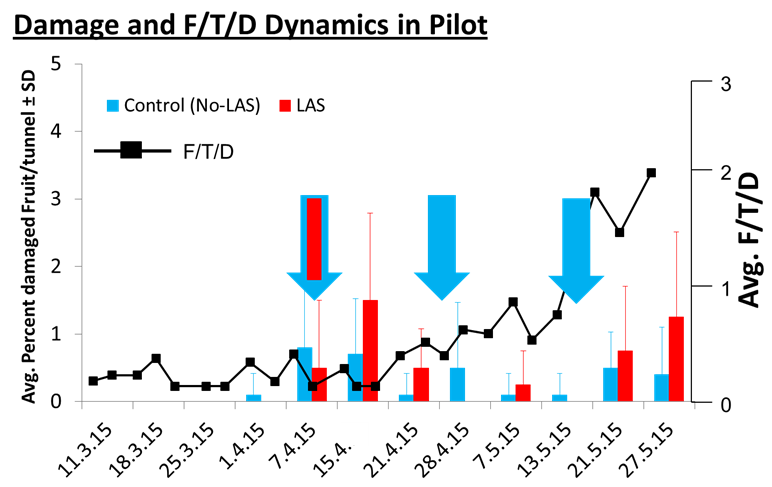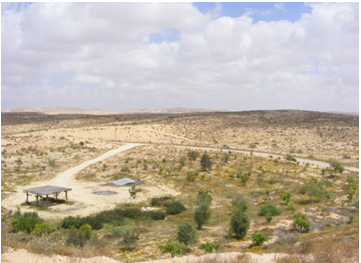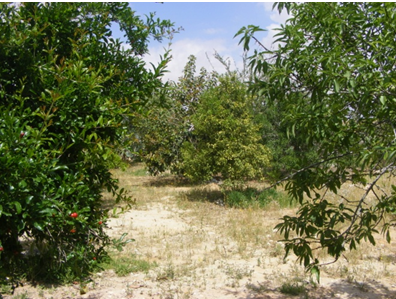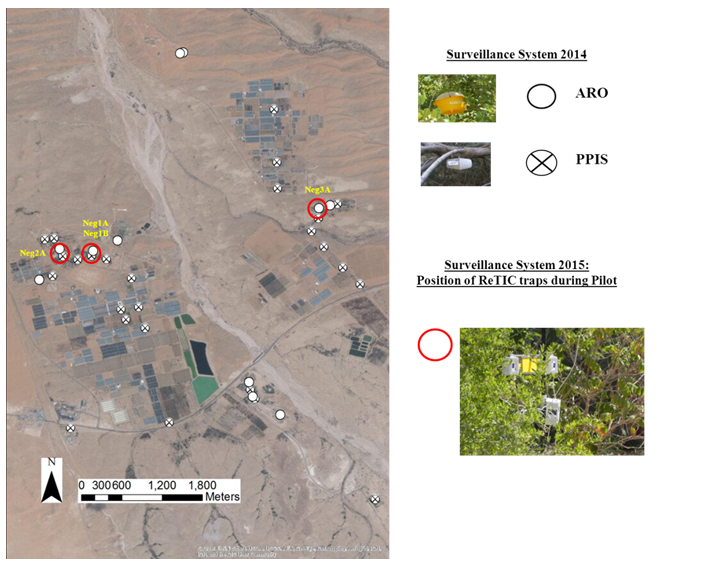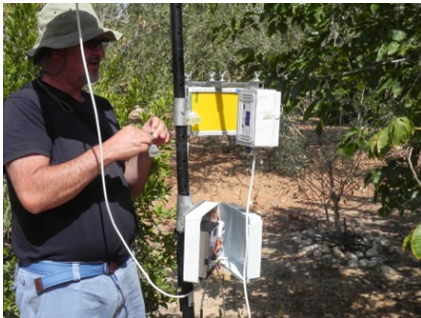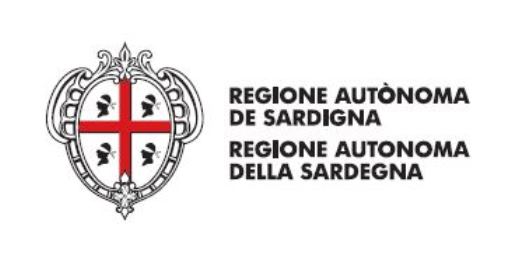The InvasiveFlyNet is developed and implemented in Israel. Background information on the Peach fruit fly and Ethiopian fruit fly are given here.
In melon tunnels in the Arava, on March 12, 2015 where deployed the first fruit fly Real Time Insect Counting Traps (ReTIC) (yellow sticky ReTIC traps). Read more here.
EIN YAHAV/ ARAVA REGION (ISRAEL)
Ein Yahav is located in the Arava valley, which runs from the Dead Sea to the Red sea. The Arava is a depression that at its lowest edge is close to 400 m below sea level. The Arava is desert shared by Israel and Jordan, and agricultural settlements are scattered throughout its 200 Km length. Ein Yahav is one agricultural settlement located in the Center of the Arava, which produces sweet peppers, tomatoes and cucurbit fruits, such as melons, zucchini, watermelon, etc. Production of fruits is mainly conducted in green-houses and growing tunnels (in the hot summer, tunnels are removed and production of melons is done in the open) using intensive production systems. The Ethiopian fruit fly (EFF) invaded the area several years ago (probably from neighboring countries), and it is now considered established in the Arava. It is under containment and checked by the Plant Protection and Inspection Services of Israel (PPIS). Information on the ecology and management of the EFF in the Arava is poor, and control is mainly exerted by prophylactic spraying of pyrethroids at a high frequency of one treatment every 15 days during the growing period. Therefore, our aim was to develop management schemes using the principles of LAS to reduce pesticide applications and damage.
During 2014 we followed the trapping patterns of the EFF and linked them to damage patterns. Around 80 yellow sticky traps were spread in the whole region and damage was closely followed in more than 20 melon growing tunnels. Results showed two main EFF population peaks (spring and fall-winter). Damage was more important during the spring than in the fall-winter season. Main results suggest that trapping and damage are loosely related and that monitoring should be conducted at a regional level. The results during 2014 showed that damage starts to increase at a level of 0.3 flies per trap per day (F/T/D). Therefore, we used the 0.3 F/T/D as our threshold in the design of a decision support system (DSS) for the LAS.

Location of yellow sticky traps in the melon growing areas of Ein Yahav during 2014. Encircled area (in orange) was used for the LAS pilot in 2015.
Yellow sticky trap used for monitoring during 2014 and for ReTIC validation during the pilot in 2015
During 2015 we only used the Southern area of the agricultural area. The LAS pilot included 10 control melon growing tunnels (750 m2) and 4 LAS melon growing tunnels. The pilot run during the spring melon season. The pilot followed EFF population trapping levels using the common yellow sticky trap and 7 ReTIC traps (remotely transmitting images of EFF captures to the scientists in the ARO). Fruit fly monitoring was combined with damage data obtained by a scout, and the data was feed into a DSS developed for the pilot. Results of the pilot were highly encouraging. Spraying of pyrethroids to control the EFF damage was reduced by almost 70% in the LAS tunnels compared to the control (No-LAS) melon growing tunnels. Damage in the two treatments was low and not significantly different. Transmission of images by the ReTIC was highly efficient and informative. Matching between the information remotely collected by the ReTIC and the information on trapping collected by a human scout visiting the traps on a frequency of two times per week during the pilot was very similar (90% matching). In addition, farmers became highly interested on the results and supported its continuation and fine tuning, which we expect to initiate in 2016.
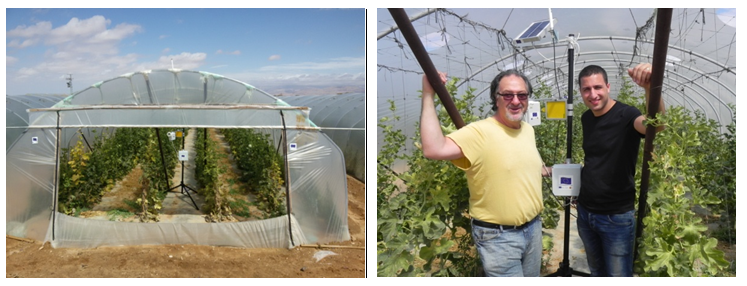


DSS developed for the management of the EFF. The DSS was constructed together with the farmers and using as a principle the prophylactic calendar spraying (15 days) and the tolerance of the farmer (22 days). The decision is based on the average amount of flies captured in the whole monitoring system during 3 consecutive days.
Figure showing a sequence of thematic maps of the pilot area showing damage levels in tunnels and trapping numbers during the operation of the LAS pilot in Ein Yahav. The figure shows that on May 10, 2015, the No-LAS tunnels were sprayed following the calendar approach. LAS tunnels were not sprayed during these dates.
Figure showing the damage trends (bars) in LAS and No-LAS melon tunnels (% of infested melons), and the patterns of EFF captures (line) during the pilot. The figure also includes the spraying dates (blue arrows for No-LAS and red for LAS). The LAS and No-LAS were sprayed in early April as a preventive spray requested by the farmer. Afterwards, the farmer followed the indications of the DSS, so LAS tunnels were not sprayed. Final damage in the LAS and No-LAS tunnels was similar and below 2% at the end of the growing season.
NITZANA PILOT/ NEGEV REGION
Nitzana is an agricultural settlement located in the Negev desert in Southern Israel. It is close to the border with Egypt. The agricultural settlement produces mainly cherry tomatoes in greenhouses. Although tomato is not a host for the peach fruit fly (PFF), the home-gardens of farmers leaving close to their greenhouses usually include PFF hosts, such as mango. Since Nitzana area limits with Egypt, where PFF has been reported, the PPIS of Israel maintains a constant surveillance for invasive fruit flies in the area. The surveillance system consists of Steiner traps loaded with Methyl Eugenol, which attracts male PFF and other Bactrocera species. The surveillance system is spread around the whole agricultural and settlement areas, and includes several tens of traps that are serviced every 2 weeks. The PPIS system serves as an Early Warning System (EWS) for the interception of invading fruit flies, especially from the Bactrocera genus. In the past, PPIS has intercepted PFF in Nitzana. Once an interception of PFF was detected, the PPIS of Israel launched an action protocol that included an increment of surveillance frequencies, quarantining of the area and applications of the male annihilation technique against the PFF with baited insecticide (usually methyl-eugenol and a pesticide). The new protocol changed the use of pesticide with mass-trapping using methyl-eugenol traps, such as plastic bottles.
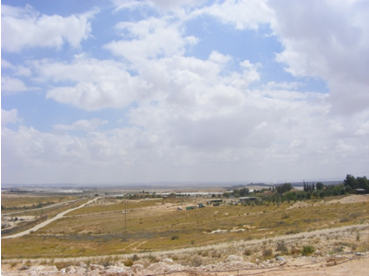
A community garden in the Nitzana region planted with hosts of the PFF.
A home garden in Nitzana. The picture shows the diversity of PFF hosts.
During 2014 we set a survey with 11 McPhail traps dispersed throughout the region. This in order to study the ability of the McPhail trap as an EWS and to search for proper areas to implement the Early Warning LAS pilot for 2015. The McPhail traps run in parallel to the PPIS surveillance system. The two systems intercepted a few flies and PPIS promptly reacted to the situation. During 2015 we set 4 ReTIC traps (yellow sticky traps loaded with Methyl-Eugenol) in locations were PFF was intercepted in 2015. The traps functioned individually and each of them was directly connected to the internet. The aim of the pilot was to explore the ability of ReTIC traps as an early warning system using the concept of LAS (specifically the location concept). We expected that the ReTIC trap will allow a more frequent surveillance system, and improve the EWS. During 2015 no interceptions were detected neither by our surveillance system nor the PPIS system. Therefore, no action was launched. Our aim for the future is to continue exploring the ability of ReTIC traps with a location component. The PPIS of Israel has expressed their interest on the project and the ability of the ReTIC system to provide early warnings of invading fruit flies.
Map showing the Nitzana area in the Arava region of Southern Israel (a region of approximately 50 km2). The area is composed of several agricultural and human settlements. The map shows the location of ARO McPhail and PPIS Steiner surveillance grid during 2014, and the position of ReTIC traps (4) during the pilot of 2015. Neg1A and Neg1B is a double trap providing images from the 2 sides of the yellow sticky trap. ReTIC traps were loaded with methyl eugenol attractant for male PFF.
Establishment of a ReTIC trap loaded with methyl eugenol in a home-garden with PFF hosts in the Nitzana region
- Details
- Hits: 2644

